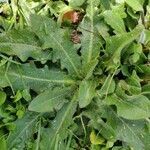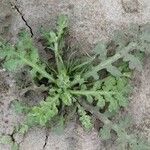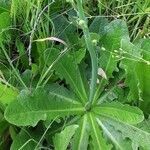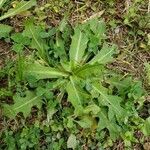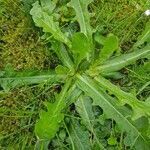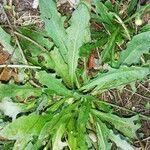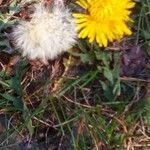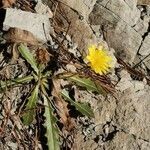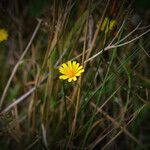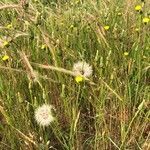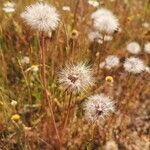Annual herb, with a rosette of leaves and flowering stems 12–80 cm high; taproot fleshy, with white latex; flowering stems one to several, not or copiously branched, ribbed, glabrous.. Leaves oblanceolate in outline, 2–14 cm long, 0.5–2 cm wide, base attenuate but amplexicaul near the stem, margins coarsely dentate to pinnatilobed, apex obtuse, glabrous or with scattered setae, mainly on midrib and margins, but occasionally over the whole surface; cauline leaves absent; inflorescence bracts linear, to 1 cm long.. Capitula solitary or in lax cymes, erect, on long bracteate stalks; involucre 13–17 mm long; phyllaries green with reddish or purplish margins, 2–17 mm long, obtuse or acute, glabrous or minutely ciliate distally, unequal, the outermost smallest.. Corolla yellow, tube cylindric, ± 3 mm long, ligule 2.5–2.8 mm long, 0.5 mm wide.. Achenes dimorphic: those of outer florets obconic, 2.7–3.2 mm long, truncate; those of inner florets fusiform, 6.5–9.5 mm long, the distal part attenuate and beaked; both types ribbed with antrorse spinules; pappus of plumose setae 7.5–11 mm long.. Fig. 18.
Annual herb, with a rosette of leaves and flowering stems 12-80 cm high; taproot fleshy, with white latex; flowering stems one to several, not or copiously branched, ribbed, glabrous. Leaves oblanceolate in outline, 2-14 cm long, 0.5-2 cm wide, base attenuate but amplexicaul near the stem, margins coarsely dentate to pinnatilobed, apex obtuse, glabrous or with scattered setae, mainly on midrib and margins, but occasionally over the whole surface; cauline leaves absent; inflorescence bracts linear, to 1 cm long. Capitula solitary or in lax cymes, erect, on long bracteate stalks; involucre 13-17 mm long; phyllaries green with reddish or purplish margins, 2-17 mm long, obtuse or acute, glabrous or minutely ciliate distally, unequal, the outermost smallest. Corolla yellow, tube cylindric, ± 3 mm long, ligule 2.5-2.8 mm long, 0.5 mm wide. Achenes dimorphic: those of outer florets obconic, 2.7-3.2 mm long, truncate; those of inner florets fusiform, 6.5-9.5 mm long, the distal part attenuate and beaked; both types ribbed with antrorse spinules; pappus of plumose setae 7.5-11 mm long.
Annuals, 10–50 cm. taproots slender, vertical; caudices small, ± herbaceous. Stems (1–30), sparingly branched at midstem or distally (lateral branches often short, minutely bracteate or naked), glabrous. Leaves usually all basal; blades oblanceolate to oblong, 20–110 × 5–30 mm, margins nearly entire to dentate or pinnatifid, faces usually glabrous or glabrate, sometimes hirsute on veins. Heads borne singly or 2–3 in loose, cymiform arrays (terminating branches, not showy) . Involucres narrowly campanulate, 8–16 × (3–)5–20 mm. Phyllaries 18–20, lanceolate, 3–18 mm, unequal, margins scarious, faces glabrous (apices brownish or reddish, sometimes ciliate). Florets 20–40; corollas white to yellowish, 5–8 mm,. equaling phyllaries at flowering. Cypselae dimorphic, outer cylindric, stout, truncate, inner fusiform, slender, beaked; bodies dark brown, 10-nerved, 8–10 mm, beaks 3–4 mm; pappi of tawny bristles in 2 series, outer barbellate, shorter than plumose inner, longest 9–10 mm. 2n = 8, 10, 12.
Herbs 10-30 cm tall, annual, rosulate. Stems 1 or few, ascending to erect, simple or apically sparsely branched, glabrous, leafless or with few triangular-ovate bracts. Rosette leaves obovate to oblanceolate, 3-5 × 0.5-1.5 cm, subglabrous to hispidulous, base narrowed, margin sinuate-dentate, apex rounded to subacute. Synflorescence single-headed or weakly corymbiform with few to several capitula. Capitulum with usually 20-40 florets; peduncle long. Involucre cylindric to narrowly campanulate, 7-10 × 3-4 mm at anthesis, 1.3-1.5 mm in fruit. Phyllaries ± glabrous; outer phyllaries lanceolate; inner phyllaries linear-lanceolate. Florets yellow, slightly longer than involucre. Achene brown, dimorphic; outer achenes cylindric, 3-4 mm, ribbed, muricate, truncate; inner achenes with fusiform body, 3-4 mm, ribbed, muricate, beak capillaceous and as long as or longer than body. Pappus 7-8 mm, inner bristles plumose, outer bristles scabrid and shorter. Fl and fr. Mar-Apr. 2n = 10.
Taprooted annual or winter-annual, essentially glabrous; stem 1–4 dm, simple or sparingly branched, naked or only sparsely and minutely bracteate; basal lvs oblanceolate, toothed or pinnatifid, 2.5–15 × 0.7–3.5 cm; heads several or solitary, terminating the branches, not very showy, opening only in full sun, the ligules ca equaling the invol and only ca twice as long as wide; invol mostly 8–10 mm at anthesis, up to 17 mm in fr, its bracts imbricate; body of the achenes mostly 4–5 mm, multinerved, the nerves muricate upward; outermost achenes usually beakless, the others with a well developed slender beak; shorter outer pappus bristles commonly merely barbellate; 2n=8, 10, 12. Disturbed and waste places, especially in sandy soil; European weed, intr. in se. U.S., n. to s. Ill.
Annual herb, 0.2-0.8 m high, with milky latex. Leaves in a basal rosette, oblanceolate, narrowed to clasping base, sinuate toothed to sinuate pinnatifid, glabrous, rarely somewhat hairy on midrib and margins. Capitula ligulate, solitary, or in lax cymes, long-pedunculate; involucre oblong-cylindrical or campanulate; bracts in several rows, glabrous or minutely ciliate. Receptacle paleate; paleae linear, acuminate. Florets bisexual; corolla yellow, strap-shaped, ± as long as involucre. Flowering time Aug.-Nov. Pappus in 2 rows, outer of short scabrid bristles, inner of long plumose bristles. Cypselae of 2 types, outer ones obconic, truncate, inner ones fusiform, beaked, both types with several ribs and transversely wrinkled.
A herb which re-grows from seed each year. It grows 20 cm high. It only has a few branches. The leaves form a ring near the base. The leaves are almost smooth and not hairy. They are narrow sword shaped. They are 1.5-10 cm long by 0.5-2 cm wide. The leaves have lobes or blunt teeth. The leaves narrow to the base and have blunt tips. The flowers occur singly in heads on the end of the stems. These flowering stems are 5-20 cm high. The flowers are less than 1 cm across. They are yellow.
Flowers from August throughout summer.
